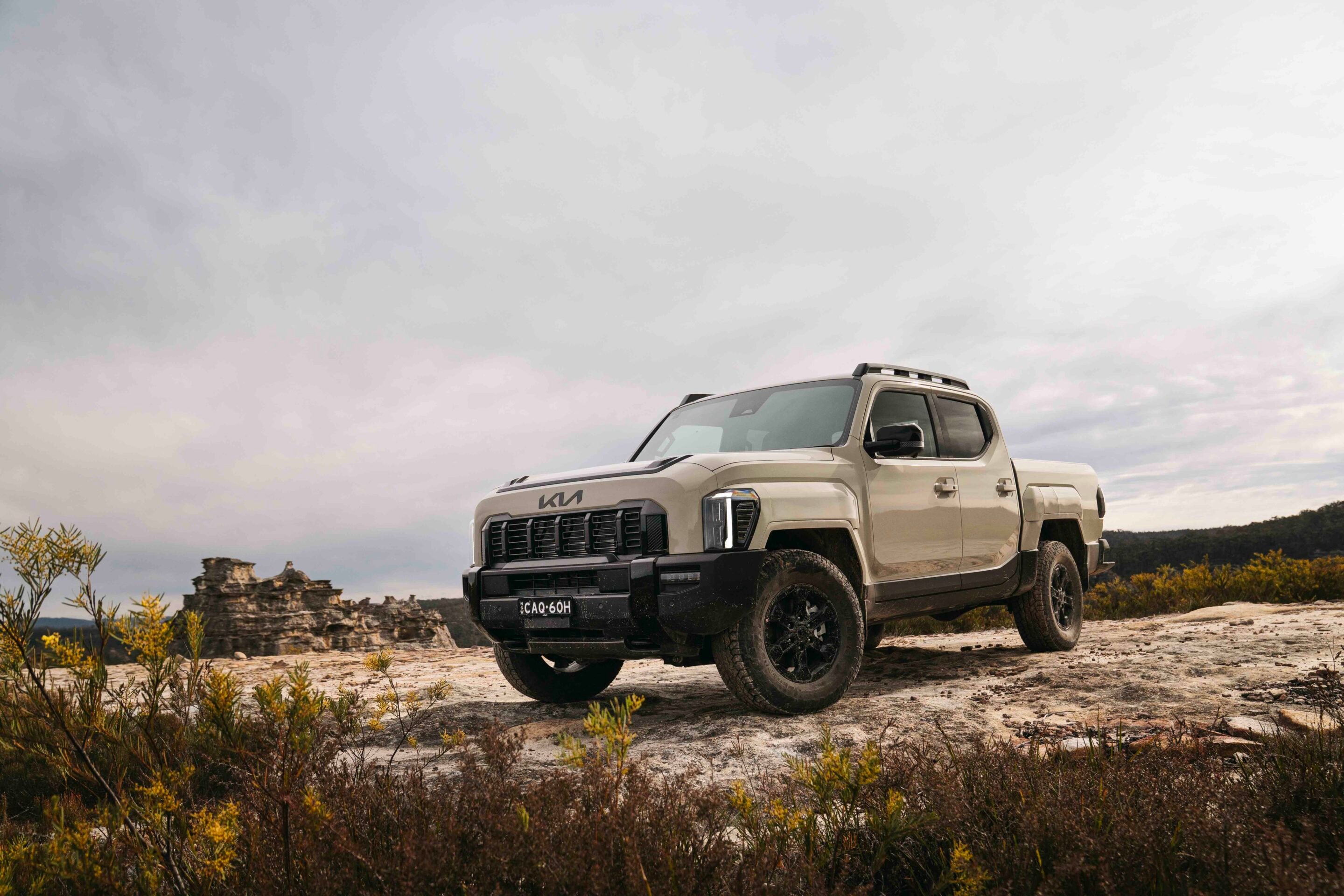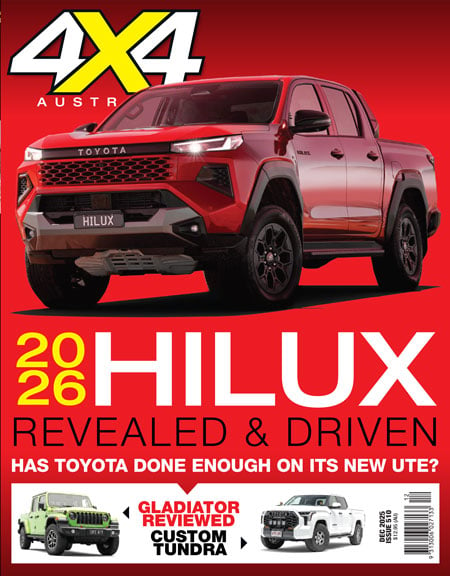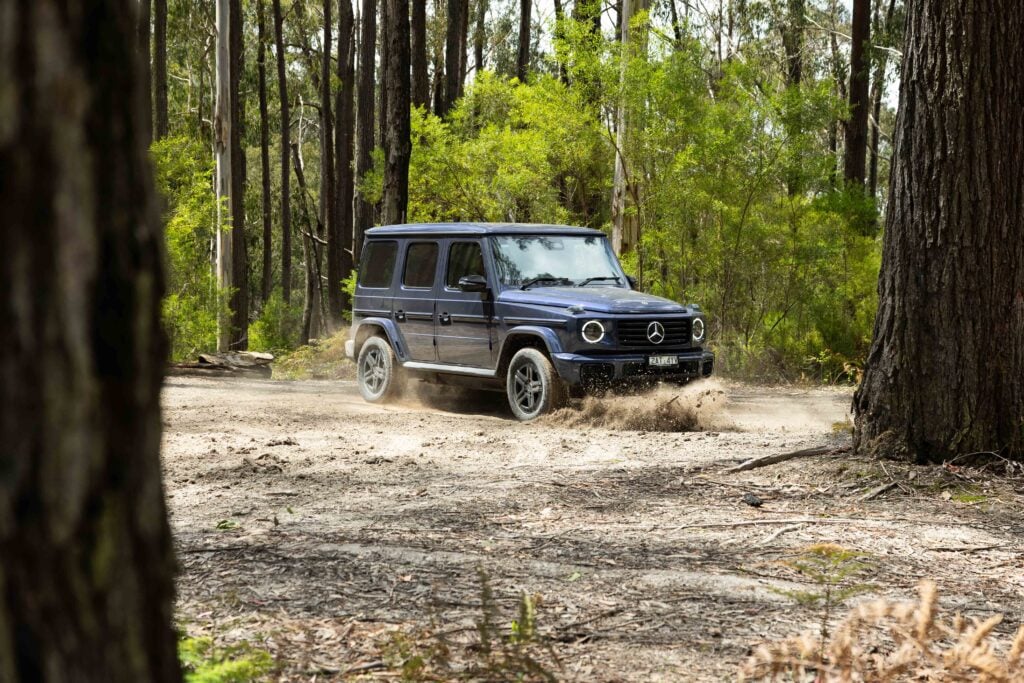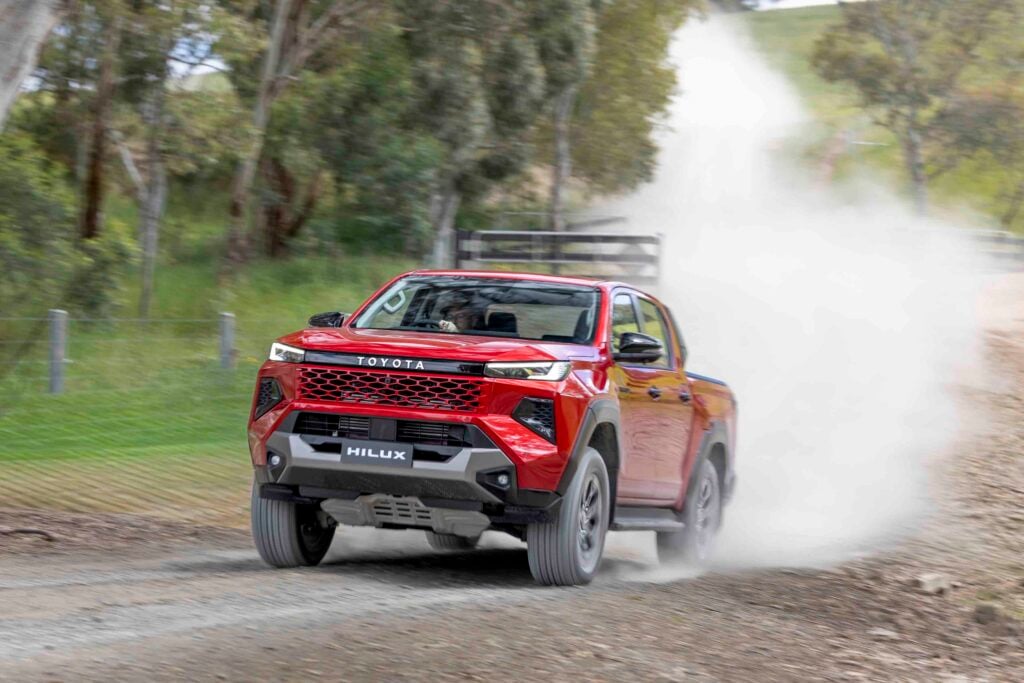Things we like
- Excellent interior design and functionality
- Composed ride and handling
- Competent off-road
- Unique styling
Not so much
- Underwhelming engine performance
- Slightly choppy ride quality
- Unique styling
The new Kia Tasman follows the popular midsize 4×4 ute recipe of being a body-on chassis pick-up powered by a diesel engine and dual-range 4×4 system.
It will be offered in both double- and single-cab configurations, as well as cab-chassis options and two-wheel drive models. From launch, the Tasman will be offered in five model grades: S, SX, SX+, X-line and X-Pro. The high-grade X-Line and X-Pro models are available in 4×4 only while the lower grades are offered in both 4×4 and 4×2 variants.
JUMP AHEAD
- Pricing, model grades and key features
- Interior features and cabin tech
- Turbo-diesel engine and drivetrain details
- Chassis, suspension and local tuning
- Safety features and ANCAP rating
- Tub dimensions, payload and accessories
- Final verdict
- Full specs
Pricing, model grades and key features
Kicking off the range at $42,990 +ORC for the 4×2 variant and $49,990 +ORC for the 4×4, the Tasman S is far from a bare-bones workhorse.
It rides on 17-inch black steel wheels with a full-size spare, and includes LED headlights, daytime running lights, and LED interior lighting. Pick-up versions gain front and rear parking sensors, a rear-view camera, a tailgate with lift assistance, rear bumper steps, and an integrated trailer brake controller.

Inside, the Tasman S offers a surprising level of tech for an entry-level ute, including Kia’s new panoramic display incorporating a 12.3-inch digital driver cluster, 12.3-inch multimedia screen and a 5-inch HVAC panel. There’s wireless Apple CarPlay and Android Auto, six speakers, cloth trim seats, and dual-zone climate control. Rear-seat passengers benefit from under-seat storage, while the driver gets push-button start, cruise control, Drive Mode Select and a smart key. Trailer Sway Control is also standard.
Moving up to the Tasman SX, priced from $54,490 +ORC, brings a host of upgrades over the base model. Steel wheels are swapped for 17-inch alloys, and drivers gain the benefit of Terrain Modes – Snow, Sand and Mud – for improved off-road performance. There’s also the addition of Smart Cruise Control with navigation-based functionality, Highway Driving Assist 2, electric folding side mirrors, and one-touch safety power windows for the front row. The SX also gains inbuilt satellite navigation.
At the top of the 4×4-focused range, the Tasman X-Line kicks off at $67,990 +ORC and builds further on the SX spec. It ditches the console-mounted T-bar shifter found in lower grades in favour of a column-mounted transmission selector and paddle shifters, freeing up space in the cabin. Comfort and convenience are ramped up with heated front seats, an eight-way powered driver’s seat, artificial leather trim, a second-row centre armrest, and sliding/reclining rear seats. There’s also a dual wireless phone charger and rear fender flare storage on select colours.
Externally, the X-Line scores privacy glass, roof rails, and larger 18-inch alloy wheels, while safety and visibility are boosted with projection-type LED headlights, a Surround View Monitor, Blind-spot View Monitor and Parking Collision Avoidance Assist.
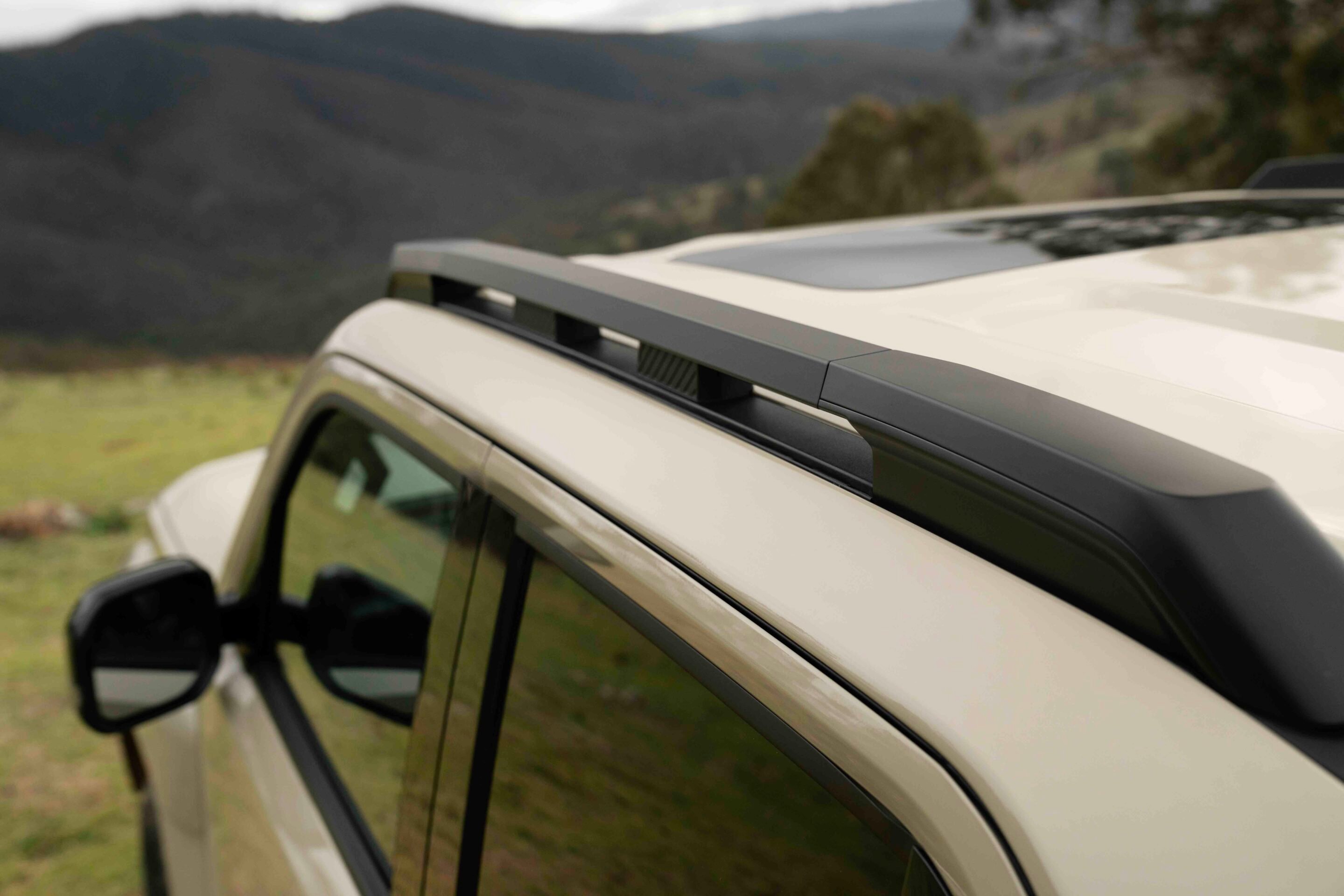
Priced from $74,990 +ORC, the flagship Tasman X-Pro builds on the X-Line’s already generous equipment list with a mix of serious off-road hardware and premium cabin upgrades. It runs 17-inch alloy wheels with all-terrain tyres, and adds an electronic locking rear differential with on/off control, an X-Trek off-road drive mode (similar to Crawl Control), and expanded Terrain Modes that now include Rock, alongside Snow, Sand and Mud. Ground View Monitor and underbody fuel tank protection bolster its off-road credentials, while a dedicated off-road display shows real-time steering angle, direction and oil levels.
Inside, the X-Pro delivers a luxury feel with a sunroof, ambient mood lighting, a heated steering wheel, ventilated front seats, heated rear seats, and an eight-way powered passenger seat. The driver also benefits from an Integrated Memory System for seat and mirror positions, while a premium Harman Kardon sound system rounds out the package.
Interior features and cabin tech
There’s been plenty of chatter about the Tasman’s exterior styling – and not all of it flattering – but once you step inside, the conversation is likely to change.
If Kia can get bums on seats, the cabin quality, layout and tech are likely to win over potential buyers. Slip through the wide-opening front and rear doors and you’re greeted by a spacious, well-equipped cabin.
All variants feature Kia’s slick dual 12.3-inch widescreens – one for the driver’s info display and the other for multimedia. A tyre pressure monitoring system (TPMS) is standard across the range, and the infotainment system includes inbuilt satellite navigation, plus wireless Apple CarPlay and Android Auto. Higher-spec models also score dual wireless phone chargers.
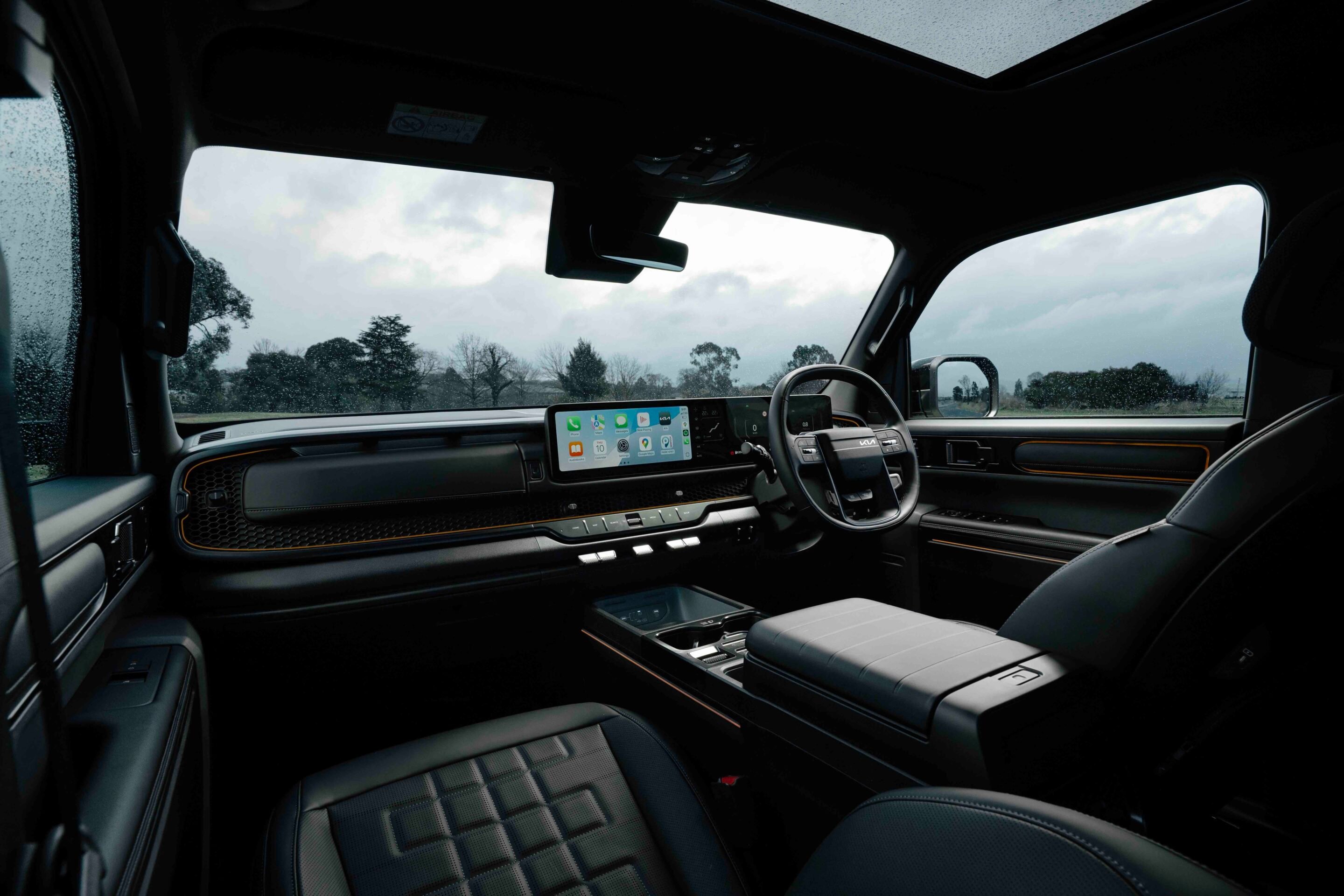
The X-Pro gets all the fruit, including heated and ventilated power-adjustable front seats, a premium sound system, and second-row seats with slide and tilt functionality. This adjustable rear bench is a real win for passenger comfort, allowing a more relaxed backrest angle – though it does bring your knees closer to the front seats. This feature is also standard on the X-Line. Like some American pick-ups, the base of the rear seat lifts to reveal a handy under-seat storage compartment.
The Tasman’s interior impresses not just for its generous width, but for the sheer level of standard equipment offered in the two X-grade models. If you’re unsure about the exterior styling, do yourself a favour – get behind the wheel at your local dealer. Chances are, the cabin and driving experience will change your mind.
Turbo-diesel engine and drivetrain details
All Kia Tasmans are powered by a 2.2-litre turbo-diesel engine producing 155kW and 441Nm, paired with an eight-speed automatic transmission.
Four-wheel drive models feature a dual-range, part-time transfer case with an additional 4×4 Auto mode that enables all-wheel drive on sealed surfaces. It’s a setup similar to what you’ll find in selected Ford Ranger variants and Mitsubishi’s Super Select-equipped Tritons – giving drivers the added safety of full-time 4×4 in wet weather or while towing.
Only the flagship Tasman X-Pro comes equipped with a selectable locking rear differential, but the other 4×4 variants aren’t left out – they feature an auto-locking rear diff. There’s no front locker available anywhere in the Tasman range. While the power and torque figures are modest compared to some rivals in the segment, they’re adequate for getting the Tasman moving – at least in the unladen, two-up vehicles we drove at launch.
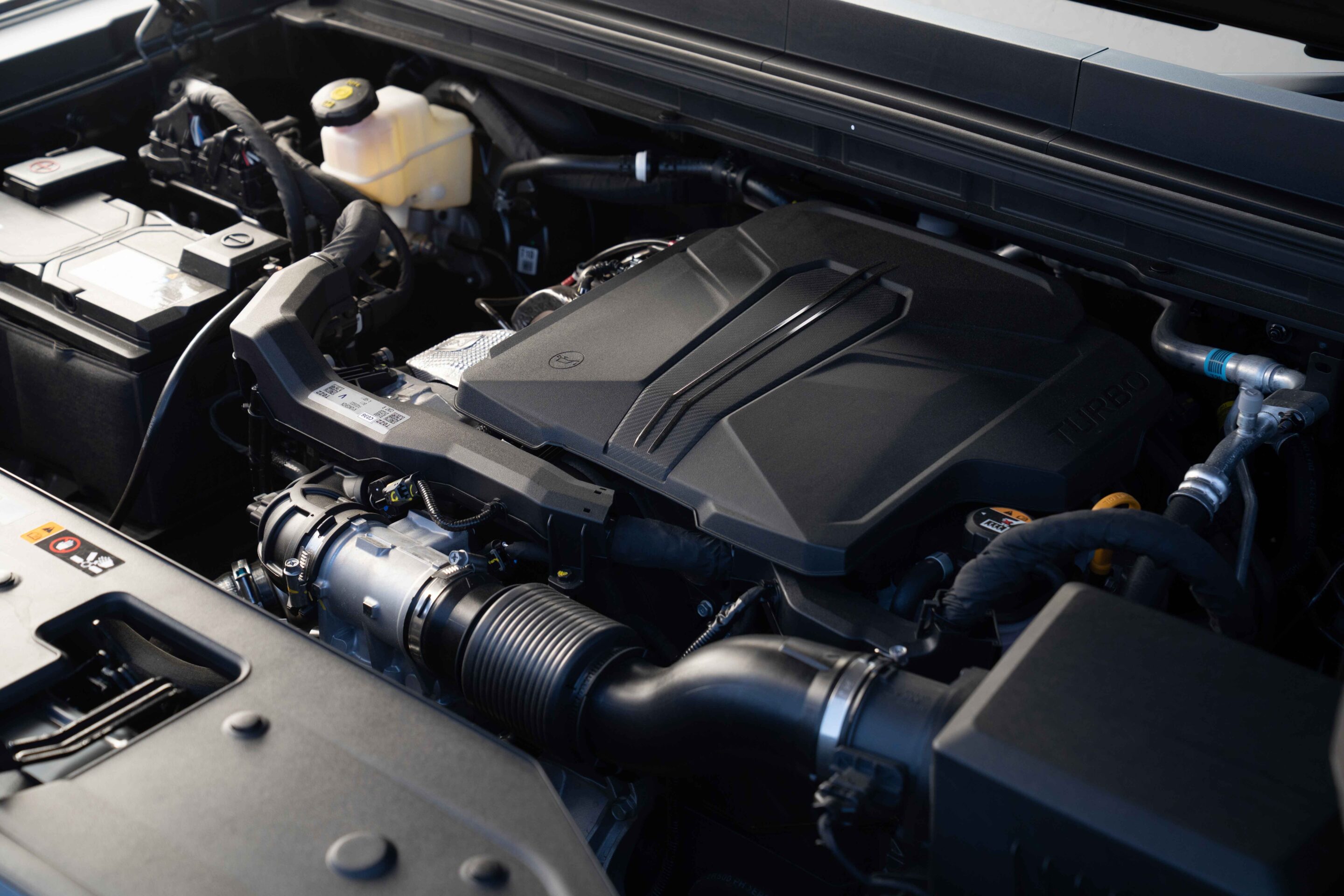
We had the opportunity to tow a caravan reportedly weighing 2000kg. With a 3500kg braked towing capacity, the Tasman 4×4 handled the load reasonably well, but I wouldn’t be keen to haul that kind of weight around the country over long distances – as many 4×4 ute buyers often do.
The 2.2-litre single-turbo engine gets the job done, but it leaves you with the sense that it’s craving a bit more grunt. A hybrid powertrain could be the answer – and with plenty of electrified options in Kia’s broader line-up, it’s a future possibility. For now, Kia says around 80 per cent of the 4×4 ute market is still powered by four-cylinder diesels, so that’s where it has chosen to start with the Tasman.
Chassis, suspension and local tuning
The Tasman doesn’t reinvent the wheel when it comes to chassis design.
Instead it sticks with the tried-and-true formula of a ladder-frame construction, live rear axle with leaf springs, and independent double-wishbone front suspension with coils. It’s a setup that works well in the unladen Tasman, delivering excellent body control over twisting, bumpy backroads.
That composure can be credited to the extensive local tuning program the Tasman underwent in Australia, with the development team spending months and thousands of kilometres fine-tuning the suspension for our roads and conditions. According to Kia, the first prototypes that arrived here had a very commercial-vehicle feel – stiff rear leaf packs and minimal roll stiffness up front – but that was quickly addressed during local testing.
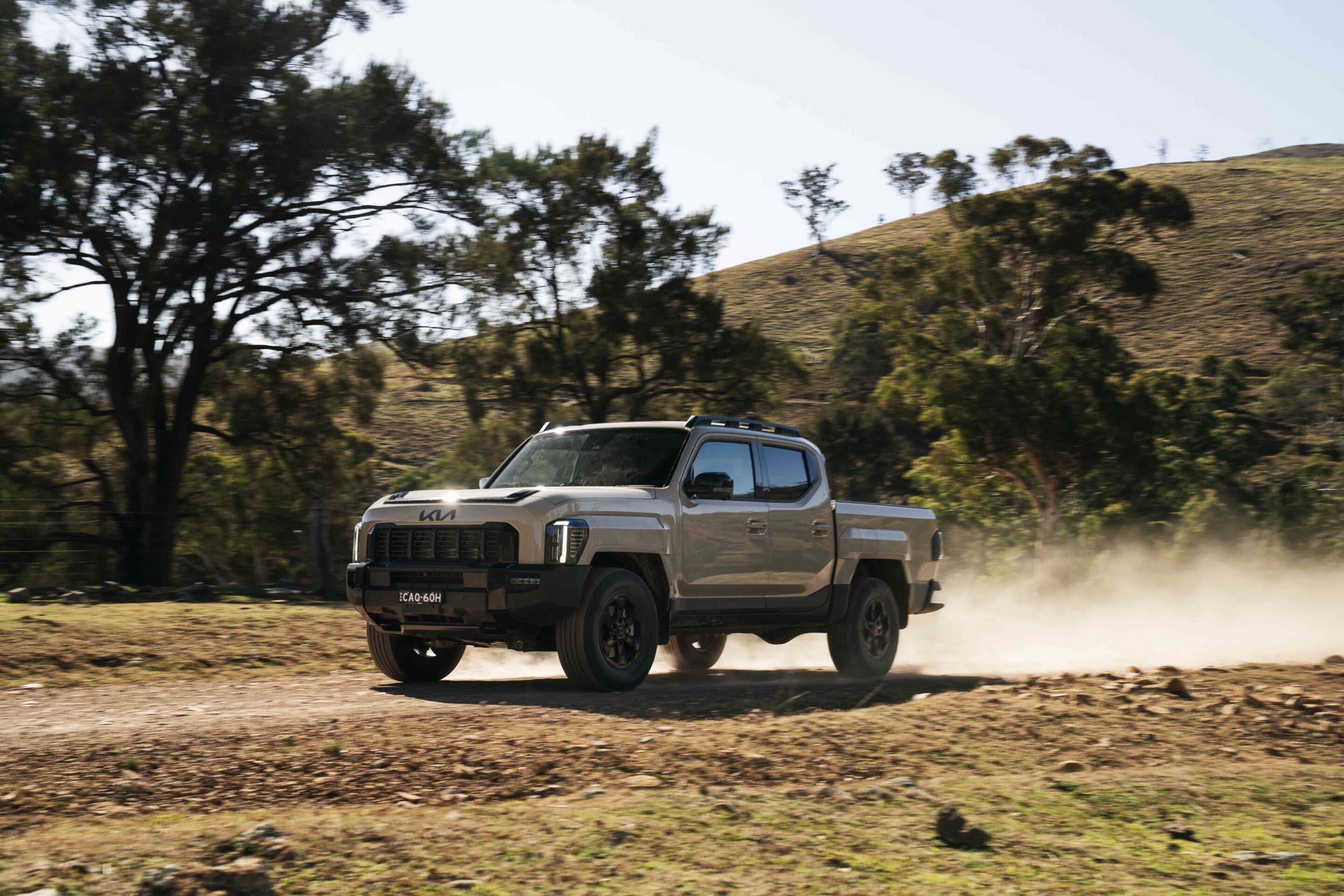
The Australian development team softened the rear suspension without compromising load-carrying ability and added front-end stiffness for improved handling. Contributing to the Tasman’s balanced ride and body control are position-sensitive dampers at all four corners – the sort of gear usually reserved for aftermarket upgrades or limited-edition models. If I had to nitpick the chassis calibration, it’d be the way the Tasman reacts to sharp bumps and potholes – delivering a jolt that unsettles the body both vertically and laterally. It’s a minor flaw in what’s otherwise a well-sorted package.
Off-road, the softer rear suspension does a great job of allowing decent wheel travel, helping keep the tyres in contact with the ground as much as possible. The steering, too, is well sorted, offering no cause for complaint.
As with the suspension, the local team has nailed the calibration of the electronic traction control (ETC), which reacts quickly and decisively when a tyre breaks traction off-road. A particularly rutted section of track put the system to the test, but engaging the rear diff lock (RDL) saw the Tasman pull through without drama.
Kia has wisely set the ETC to remain active even with the RDL engaged, helping compensate for the absence of a front locker. Many manufacturers disable ETC on both axles when the rear locker is engaged, leaving the front as a single spinner and hampering progress when traction is lost.
| Off-road specs | |
|---|---|
| Approach angle | 32.2 |
| Rampover angle | 25.8 |
| Departure angle | 26.2 |
| Ground clearance | 252mm |
| Wading depth | 800mm |
Safety features and ANCAP rating
The Tasman comes equipped with all the ADAS tech and safety hardware required to achieve a five-star ANCAP rating – and that’s exactly what the entry-level S and SX variants have done.
However, the higher-grade X-Line and X-Pro models haven’t been tested, as they’re unlikely to meet the latest pedestrian safety requirements. According to Kia, this is a deliberate move to preserve off-road capability, which would have been compromised if the vehicles were modified to meet those stricter standards.
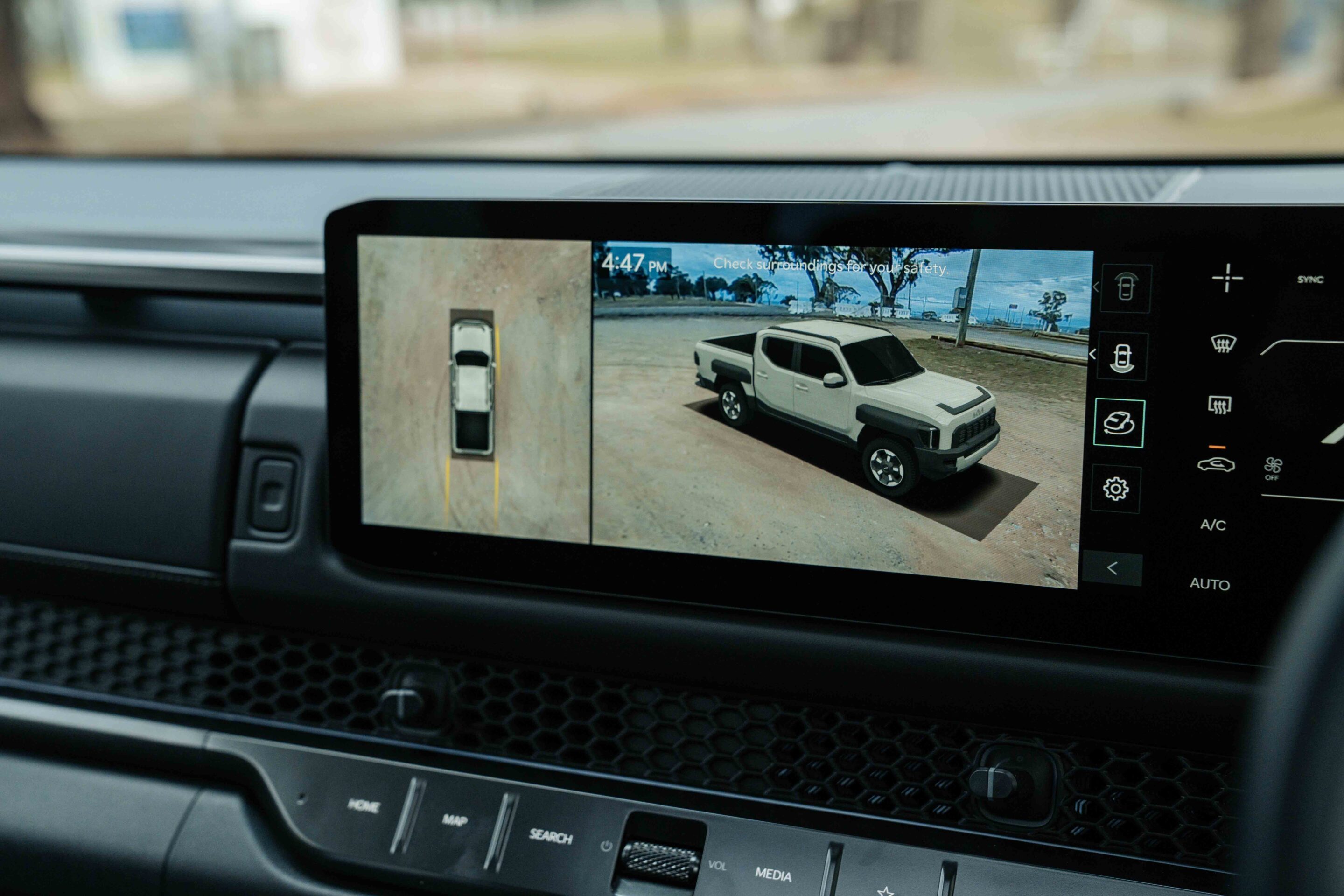
To meet pedestrian safety standards, the S and SX models wear a front chin spoiler – a panel not unlike the old cow-catchers on steam trains – designed to reduce the chance of a fallen pedestrian sliding under the front of the vehicle. When we first saw it, we assumed it would be torn off at the first off-road obstacle. As it turns out, Kia had the same thought and opted to leave it off the more off-road-focused X-Line and X-Pro variants to preserve their approach angle.
As a result, those top two models won’t be getting an ANCAP rating. All other safety features – including body strength, ADAS tech, and active and passive systems – are consistent across the range. The S and SX have a 20-degree approach angle, while the X-Pro offers a much more off-road-ready 32.2 degrees thanks to its higher ride height and the absence of the front underbody panel.
Tub dimensions, payload and accessories
Dual-cab pick-up Tasmans set a new benchmark for tub dimensions, offering enough space to fit an Australian pallet and boasting a total capacity of 1173 litres.
The tub measures 1512mm long, 1572mm wide and 540mm deep. A spray-in bedliner and tie-down points are standard, while upper-grade models add a tub-mounted work light and a 240V power outlet – complemented by a second 240V socket inside the cabin at the rear of the centre console.
All Tasman variants offer a payload exceeding 1000kg, although Double Cab Pick-Up models can be specified with a sub-1000kg payload to suit novated lease requirements. Extra storage is also available outside the tub, with a lockable cubby box integrated into the off-side rear body moulding – provided the mouldings are unpainted. Only the tan and white Tasmans come with body-coloured mouldings as standard from the showroom.

Tasmans are available with a mix of 17- and 18-inch wheel and tyre combinations, but it’s the X-Pro that offers the most practical setup – 17-inch alloy rims fitted with all-terrain tyres. A full-size spare on a matching alloy wheel is standard.
Kia has developed a comprehensive range of factory-backed accessories for the Tasman, including a full bullbar, single-hoop nudge bar and a no-hoop steel bumper replacement. Buyers can also opt for powered or manual roller shutters, chassis-mounted steel side steps, and a snorkel. The intake runs through the inner ’guard to help limit water ingress, supporting the Tasman’s 800mm wading depth – with or without the snorkel fitted.
Front and rear rated recovery points will be available, though the front points are only compatible with the replacement bumper and bullbar setups. Roof racks have been developed in partnership with Yakima, allowing full integration with the brand’s accessory system. Additional Yakima rack mounts can be fitted atop the tub and roller shutter for extra carrying capacity. A selection of sports bars will also be offered.
Kia offers both steel and aluminium tray options for cab-chassis buyers, and is actively sharing vehicle data with aftermarket manufacturers to support the development of trays, canopies and other accessories tailored to the new Tasman. Some aftermarket brands have already begun showcasing gear for the Tasman – and there’s plenty more to come.
Final verdict
Some may argue the midsize 4×4 ute market is overcrowded, but there’s no sign of it slowing down.
The Toyota HiLux and Ford Ranger remain among Australia’s best-selling vehicles, with a strong line-up of established competitors behind them. Newcomers like the BYD Shark and GWM Cannon Alpha are also proving they have the goods to lure buyers away from the established players.

The Kia Tasman is likely to land somewhere between the segment leaders and the newer challengers, going head-to-head with the likes of the Nissan Navara, Isuzu D-MAX, Mitsubishi Triton and Mazda BT-50. It’s a quality offering from a respected brand that sticks closely to the proven ute formula – while bringing a few of its own character traits to the mix.
The Tasman’s cabin and interior are its headline acts – well worth experiencing firsthand – while its chassis dynamics are impressively sorted and clearly tuned for Australian roads and conditions. That capability extends off-road, where the Tasman feels solid and composed.
While some buyers may choose to wait and see how it performs in the real world – or hold off for a future electrified variant – there’s no substitute for getting behind the wheel and taking it for a test drive yourself.
Specs
| 2025 Kia Tasman X-Pro | |
|---|---|
| Price | $74,990 +ORC |
| Engine | Diesel I4 |
| Capacity | 2151cc |
| Max power | 154kW @ 3800rpm |
| Max torque | 440Nm @ 1750-2750rpm |
| Transmission | 8-speed automatic |
| 4×4 system | Part time/dual range 4×4 with on demand mode |
| Construction | Double-cab ute body on ladder-frame chassis |
| Front suspension | IFS with double wishbones and coil springs |
| Rear suspension | Live axle with leaf springs |
| Tyres | 265/70R17 on alloy wheels |
| Kerb weight | 2237kg |
| GVM | 3250kg |
| GCM | 6200kg |
| Towing capacity | 3500kg |
| Payload | 1013kg |
| Seats | 5 |
| Fuel tank | 80L |
| ADR fuel consumption | 8.1L/100km |
Things we like
- Excellent interior design and functionality
- Composed ride and handling
- Competent off-road
- Unique styling
Not so much
- Underwhelming engine performance
- Slightly choppy ride quality
- Unique styling
We recommend
-
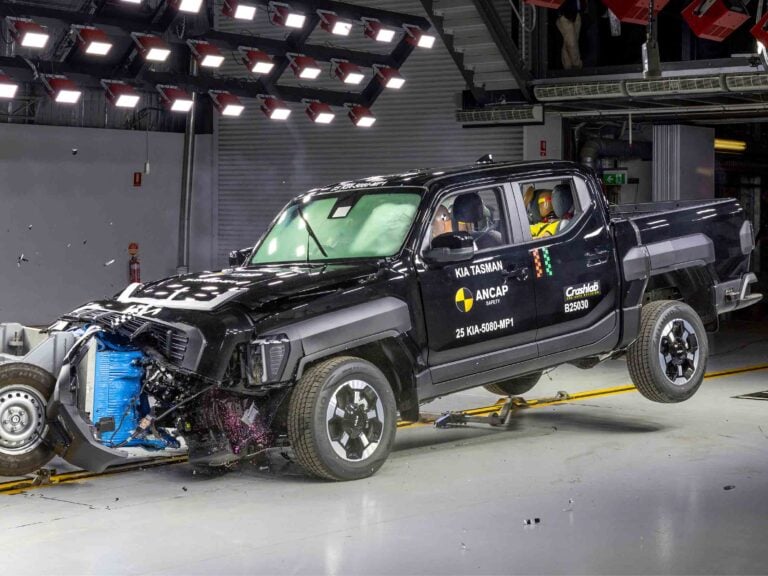 News
News2025 Kia Tasman hits the ground running with five-star ANCAP safety rating
Kia’s first purpose-built off-road ute scores five-star ANCAP safety rating on debut
-
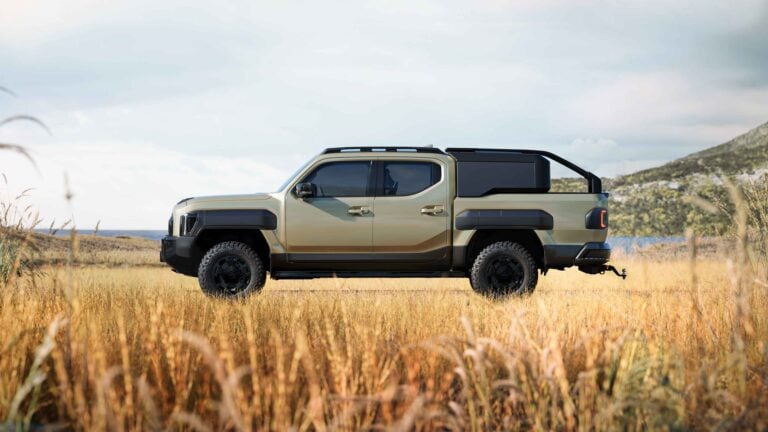 News
News2025 Kia Tasman: Genuine accessory pricing revealed
Kia reveals full accessory pricing for the new Tasman ute, ahead of imminent Australian launch
-
 News
News2025 Kia Tasman conquers Beer O’Clock Hill
Kia’s new Tasman proves its off-road credentials by tackling Beer O’Clock Hill in near-stock form at Springs 4x4 Park


